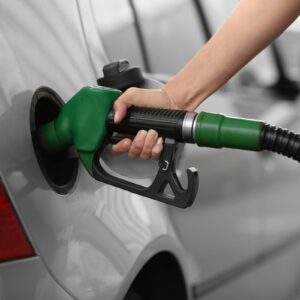Running out of diesel exhaust fluid is a problem you don’t want to have. If you ever run out, drive to the nearest gas station and replenish your supply immediately. When your storage tank runs empty, you can expect your vehicle to display the following signs:
- Your car slows down to a crawl.
- Your DEF header gets damaged.
- Your exhaust system may become clogged and malfunction.
What Is Diesel Exhaust Fluid and What Is It For?
Diesel Exhaust Fluid (DEF) is a special fluid that exists to reduce the emission of nitrogen oxide with the help of a catalytic converter. This conversion is accomplished through a system called selective catalytic reduction or SCR.

This system causes chemical reactions within your car’s catalyst chamber, transforming the harmful gasses created by diesel fuel into breathable nitrogen and water.
What Is DEF Made Of?
DEF is a specially-made fluid composed of 32.5% urea and 67.5% deionized water.
If you’re curious about why or how urea is even a part of this equation, don’t be alarmed. The urea used in the creation of DEF doesn’t come from any natural source.
While urea is indeed an organic compound, it can also be created synthetically with ammonia and carbon dioxide.
When it comes to DEF, it’s a good idea to avoid cutting costs. High-quality DEF goes a long way in terms of increasing the longevity of your catalytic converter. Taking care of your DEF is just as important, so don’t use expired fluid, and don’t leave it sitting in the sun. Doing so would decrease the quality of your DEF.
Taking care of your DEF is just as important, so don’t use expired fluid, and don’t leave it sitting in the sun. Doing so would decrease the quality of your DEF.
–Anthony Harlin, ASE Certified Master Automobile Technician
How Does DEF Work?
DEF is injected into the diesel exhaust before entering your car’s catalytic converter. The reaction to convert harmful gasses into breathable ones occurs in the catalyst chamber.
Since DEF is made out of urea and deionized water, this fluid can be vaporized through SCR to create ammonia and carbon dioxide.
The chemical reactions caused by SCR convert toxic nitrogen oxide into less harmful reagents. The ammonia generated converts nitrogen oxide into nitrogen and water, which are both harmless to the environment.
How Do I Know if I’m Low on DEF?
If you’re unsure if you’re running low on DEF, you can check for yourself by examining your dashboard. Most vehicles have an indicator lamp dedicated to how much DEF you have, changing colors and states depending on the levels of fluid remaining:
- Flickering Amber: Your DEF levels are at 5% or below.
- Solid Amber: Your DEF levels are at 2.5% or below.
- Solid Red: Your DEF levels are at 0%, completely dry.
There is a storage tank you can inspect if you want to check your vehicle’s DEF level manually. This tank is normally found beside the diesel fuel saddle tank on trucks. As for passenger cars, the DEF storage tank is normally found in the spare tire and tool storage area.
Despite this, not every vehicle has a DEF gauge. In this case, your best bet would be to simply top off your DEF with every oil change — especially if you can’t gauge how much you have left. Sometimes, sensor systems can fail to detect how much DEF you really have, and in this case, a top-off will keep reserves full.
How Long Does DEF Last?
Fortunately, modern diesel vehicles have a dashboard warning system that lets you know when it’s time to replace or refill your DEF. One gallon of DEF should last you approximately 300 to 500 miles. So long as your DEF tank never goes empty, you can expect a smooth and steady driving experience.

How Do You Know How Much DEF You Need?
Most DEF storage tanks require one gallon of DEF for every 50 gallons of diesel fuel. It’s a good practice to top off every now and then to avoid putting yourself in a difficult situation.
What Happens if You Run Out of DEF?
In most cases, running out of DEF means you just have to refill the tank and your vehicle will be good to go. However, this isn’t always the case, and sometimes running your DEF tank dry leads to serious consequences. For example, your vehicle could enter a state known as limp mode, where the vehicle’s speed limit gradually decreases until it can no longer be driven.
Fortunately, you will receive warnings from your vehicle that let you know when it’s time to refill the DEF tank before it enters limp mode. It’s important to get your tanks refilled as soon as possible. The lower you let the speed limit get through limp mode, the more money you’ll need to spend on diagnostics fees, repairs, and unlocking the vehicle.
In the event that your vehicle gets totally locked by limp mode, it’s a good idea to bring it to a repair facility where a dealer-level scan tool can unlock it.
In addition, running your DEF storage tank dry puts you at risk of far more severe problems, albeit ones that are more uncommon. You run the risk of clogging your exhaust system with gunk.
A clogged exhaust system leads to several problems for your vehicle:
- The stench of diesel and smoke in your car.
- Loud noises from the exhaust and the engine.
- Difficulty accelerating and moving at reasonable speeds.
Emptying a DEF storage tank also has the potential to damage your DEF header–a sensor that measures the level, temperature, and quantity of DEF in your tank. Replacing your DEF header can be expensive and cost you up to $1,200.
Bear in mind that your DEF tank might get flagged as empty when it’s not. If this happens, there’s a good chance there might be something wrong with your vehicle’s DEF level sensor assembly. The level sensor is usually serviced as part of the whole DEF tank, so bring your vehicle to an auto shop for maintenance if you feel there’s something wrong.
Can You Drive With Low DEF?
While it is possible to drive with low DEF levels in the storage tank, it is not recommended.
If your vehicle runs out of DEF, you’ll notice a sharp decrease in your vehicle’s speed. You’ll have enough speed to drive home or to the nearest gas station, but it’s ill-advised to drive anywhere else.
Driving while your DEF indicator lamp on also damages your vehicle, and doing so continuously means your engine might force itself to shut down.
Which Vehicles Need DEF?

If your vehicle has a diesel engine and was manufactured after 2010, there’s a good chance it needs DEF. After all, diesel-powered vehicles built after 2010 are required to have SCR.
SCR systems are installed in passenger cars and heavy-duty engines that run on diesel. Because of this, you can expect the following vehicles to use DEF:
- Buses
- Trucks
- RVs
- Vans
- Passenger cars
The Benefits of Using DEF
Aside from being better for the environment, using DEF comes with many benefits that will help you save a lot of time and money in the long run.
Less Maintenance
SCR engines that use DEF typically last longer than the ones that don’t. Since DEF isn’t harmful to the components of your engine, you won’t have to bring them in for repairs as frequently. You also won’t have to worry as much about your vehicle randomly breaking down.
Better for Your Health and the Environment
Diesel fumes are toxic greenhouse gasses that pollute the air, causing acid rain and contributing to the greenhouse effect. They are also directly linked to the development of asthma, cancer, bronchitis, and numerous cardiovascular diseases. Since DEF minimizes the amount of nitrogen oxide released into the air, it is much better for your health and the environment as a whole.
More Efficient for Your Engine
Using DEF generally makes your vehicle last longer because the production of toxic gasses is minimized. This means the combustions in your vehicle’s engine are more efficient and you’ll use less fuel. DEF also reduces power consumption, and you won’t need to change your oil as frequently.
Any information provided on this Website is for informational purposes only and is not intended to replace consultation with a professional mechanic. The accuracy and timeliness of the information may change from the time of publication.






























